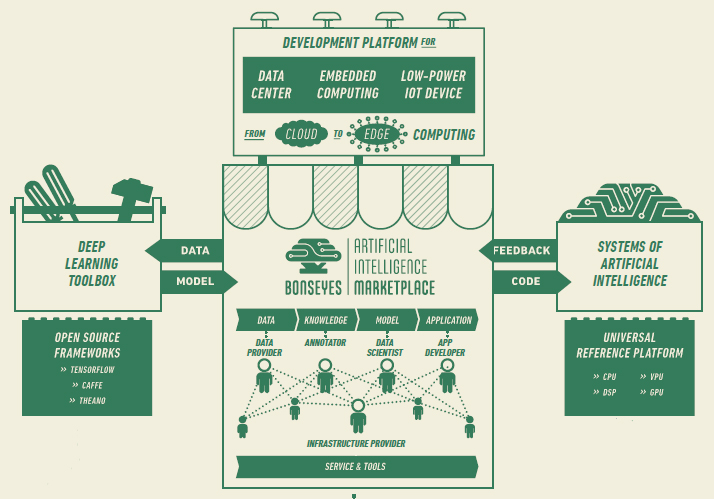Platform for open development of systems of artificial intelligence emerging as a key growth driver in Smart CPS systems in the next decade.
Context and challenges
Bonseyes aims to solve two key challenges: the strong industrial need to address data network effects and data wall problems of building systems of artificial intelligence at the European level.
More specifically Bonseyes will:
- Address the programming and design challenges of distributed architectures and autonomy of systems. It will do this by managing and synthesizing the “data deluge” created as we operate ever larger software systems with billions of connected, sensor enabled devices.
- Reduce the time of development and cost of ownership of the ever-growing roles of data analytics and machine learning in distributed and autonomous systems.
Objectives
To create a platform for open development of systems of artificial intelligence emerging as a key growth driver in Smart CPS systems in the next decade. Opposed to monolithic system design currently used in closed end-to-end solutions, Bonseyes will focus on an open architecture to enable an eco-system of companies to collaborate in building complex distributed “intelligent” systems:
- Reduce development time by 50%.
- Reduction in cost of ownership by a factor of 5 related to training of deep learning models.
- Reduction in computational and memory by a factor of 10.
- Demonstrate building four challenging scenarios within 12 months.
Partners and funding
nVISO Sàrl (Switzerland)
Universidad de Castilla-La Mancha (Spain)
Trinity College Dublin (Ireland)
The University of Edinburgh (United Kingdom)
Fachhochschule Nordwestschweiz FHNW (Switzerland)
Klinikum rechts der Isar der Technischen Universität München (Germany)
Institute of Communications and Computer Systems (Greece)
SYNYO GmbH (Austria)
ARM LIMITED (United Kingdom)
ZF Friedrichshafen AG (Germany)
RT-RK (Serbia)
SCIPROM Sàrl (Switzerland)
Blekinge Tekniska Högskola (Sweden)
Funded by the European Union’s Horizon 2020 research and innovation programme
Results

Deep Learning Toolbox
The Deep Learning Toolbox will extend existing open source deep frameworks to provide a set of components that are tailored for embedded, constrained, distributed systems operating in real environments with power, memory, and speed constraints.
It will move deep learning research from predictive performance of large scale centralised models to cost-sensitive, distributed, sparse satisficing models that are robust to changes in data environments and real-life dirty data scenarios. The toolbox will provide functions and interfaces to measure accurately the true cost of running a given model on a given target platform.
The toolbox for deep learning in embedded systems will enhance existing standardised middleware packages (e.g. Tensorflow) that are not tailored for most embedded architectures.
Artificial Intelligence Marketplace
Bonseyes Marketplace is an open and expandable platform. It supports scenarios where data must remain in the data provider’s premises and online learning with distributed CPSs. In contrast to existing solutions, it keeps human actors in the loop by allowing for continuous feedback for evaluating the performance of the models and obtaining metadata about context and the users’ perspectives.
Heterogenous Computing
Bonseyes will support multiple Universal Developer Reference Platforms with pre-integrated middleware via open source and vendor packages. Support for a wide array of Multicore CPUbased platforms, GPUs, VPUs, and DSPs without the need for time consuming and specialized engineering development.
Artificial Intelligence Demonstrators
Automotive Safety and Cognitive Computing
- Scene, people and driver detection, to trigger active or passive safety systems
- In-vehicle driver assistant, able to personalize the driver experience
Consumer Emotional Virtual Assistant
- An emotional virtual assistant will be implemented for natural HMI interactions
- Communication between API services and users will also be implemented
Healthcare Patient Monitoring
- Use of smart low-power devices to plan and schedule further diagnostic procedures
- Prediction of further diagnostic




